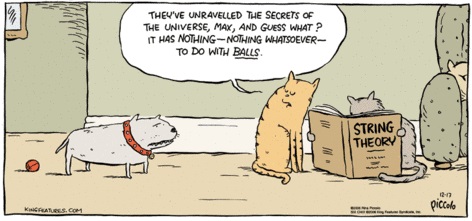Science Seen Physicist and Time One author Colin Gillespie helps you understand your world.
String Things
One of the neat things about the way the universe began is that it brings out principles that help to follow physics and philosophy that, without them, appear beyond reason. They simplify what lies behind some deep ideas, such as strings.
String theories abound in many versions. They are based on fancy math. Their math needs space dimensions that we cannot see. The simplest versions call for six. Is this fantasy or is it truly deep?
Well, why can’t we see them? Let’s start in 1926; Swedish physicist Oskar Klein suggests such a dimension could be real but ‘compactified’. He doesn’t say just how or when it got that way. But think of it like this: Take any D of the 3-D we see. Thanks to Einstein we know that its ends aren’t at infinity, it is a loop. Imagine it’s fantastically elastic. It shrinks to Planck size, far, far smaller than the smallest thing that physics can detect. Abracadabra! It’s compactified (such an uglified word). Klein’s suggestion is a step toward the first string theories.

String theories are background dependent: They build small wiggly things in assumed space and time. These in turn are both assumed to be continuums, meaning they can be sliced smaller ad infinitum. This makes their math easier. But there’s a move afoot in physics (Einstein maybe started it) to say this is all wrong.
So try this on: It’s simpler to consider that the six dimensions didn’t shrink; they started out that way. They are real, tiny 6-D quanta with properties of volume and of replication. They make space and time and thus explain the 3-D that we see. With no continuum.
This concept saves string theorists from squishing quantum strings into a continuum for no better reason than to make them match the math they learned in school. Now, who was it took that course in reeling, writhing and the branches of arithmetic?
Further reading:
Curling up extra dimensions in string theory http://physics.aps.org/story/v1/st7

No comments yet.